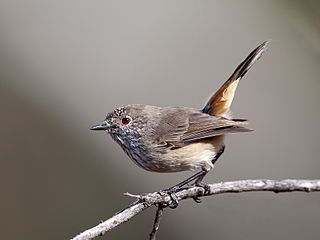
The spinifex pigeon, also known as the plumed-pigeon or gannaway pigeon, is one of three endemic Australian bird species within the genus Geophaps. It occurs within a broader group known as bronzewing pigeons. This species is listed under the International Union for Conservation of Nature (IUCN) Red List category of "least concern". It most frequently occurs in arid and semi-arid habitats containing hummock-forming grasses of the genera Triodia and Plectrachne.

Acanthiza is a genus of passeriform birds, most endemic to Australia, but with two species restricted to New Guinea. These birds are commonly known as thornbills. They are not closely related to species in the hummingbird genera Chalcostigma and Ramphomicron, which are also called thornbills.

The yellow-rumped thornbill is a species of passerine bird from the genus Acanthiza. The genus was once placed in the family Pardalotidae but that family was split and it is now in the family Acanthizidae. There are four subspecies of yellow-rumped thornbill. It is a small, brownish bird with a distinctive yellow rump and thin dark bill. It inhabits savannah, scrub and forests across most of Australia and eats insects. The species engages in cooperative breeding.

The weebill is a species of bird in the family Acanthizidae. It is an insectivorous passerine that is found throughout mainland Australia. At 8 to 9 cm long, it is Australia's smallest bird. It was originally described by John Gould in 1838, and four subspecies are recognised. The weebill's plumage is nondescript, with olive-grey upperparts and paler, more yellowish underparts. It grades from more brownish plumage in the southern regions of Australia to more yellow in tropical areas.

The little grassbird is a species of Old World warbler in the family Locustellidae. It is found in Australia and in West Papua, Indonesia. These sexually monomorphic birds are found in reed beds, rushes, lignum swamps and salt marshes of Southeastern Australia.

The inland thornbill was originally described by English ornithologist John Gould in The Birds of Australia. Inland thornbills are within the order passerines. The inland thornbill belongs to the genus Acanthiza, which now has three more species than the eleven outlined by Gould in The Birds of Australia. The Noongar people of southwestern Western Australia call A. apicalis "Djoobi-Djoolbang". The inland thornbill is also known as the broad-tail thornbill and presently contains several subspecies that were once considered independent species. The word apicalis comes from the Latin for 'tipped'.

The black-eared cuckoo is a species of cuckoo in the family Cuculidae. Found across Australia, it migrates to eastern Indonesia and southern New Guinea. They are usually observed by themselves or in a pair as they don't raise their own young, rather they leave eggs in another species nest to be raised by host. This species was formerly placed in the genus Chrysococcyx.

The striated thornbill is a species of bird in the family Acanthizidae. It is endemic to Australia, where its natural habitat is subtropical or tropical dry forests.

The chestnut-rumped thornbill is a small passerine bird in the family Acanthizidae, endemic to Australia.

The striated grasswren is a small, cryptically coloured ground-dwelling species of wren-like bird in the family Maluridae, endemic to Australia. It occupies a large discontinuous range across arid and semi-arid areas of western, central and southern Australia where it is associated with spinifex (Triodia) grass.

The striated fieldwren is a species of bird in the family Acanthizidae, endemic to Australia.

The speckled warbler is a species of bird in the family Acanthizidae. It is endemic to eastern Australia. Its natural habitat is temperate forests.

The chestnut quail-thrush is a native Australian bird of the family Cinclosomatidae. These scrub birds are endemic to Australia and found in all states - barring Tasmania. They are relatively uncommon and are isolated to the semi-arid and arid fringes of the Australian interior.

The bristlebirds are a family of passerine birds, Dasyornithidae. There are three species in one genus, Dasyornis. The family is endemic to the south-east coast and south-west corner of Australia. The genus Dasyornis was sometimes placed in the Acanthizidae or, as a subfamily, Dasyornithinae, along with the Acanthizinae and Pardalotinae, within an expanded Pardalotidae, before being elevated to full family level by Christidis & Boles (2008).

The chestnut-rumped heathwren is a species of bird in the family Acanthizidae. It is endemic to temperate and subtropical forests and heathlands of Australia.

The redthroat is a small, mostly ground-dwelling species of bird in the family Acanthizidae. It is endemic to Australia, occurring mostly in arid and semi-arid areas containing acacia and chenopod shrublands. The species has a distinctive red throat patch and is able to mimic the calls of numerous other bird species.

The emu-wrens (Stipiturus) are a genus of passerine birds in the Australasian wren family, Maluridae. They are found only in Australia, where they inhabit scrub, heathland and grassland. They are small birds, 12–19 cm long with the tail accounting for over half of their length. The tail has only six feathers which are loose and coarse in structure, rather like the feathers of the emu. Three species are recognised, of which the mallee emu-wren is endangered.

The mallee emu-wren is a species of bird in the Australasian wren family, Maluridae. It is endemic to Australia.

The western fieldwren is a species of bird in the family Acanthizidae, endemic to southwestern Australia. It is often considered a subspecies of the rufous fieldwren, most notably by Christidis and Boles in their 2008 work, but as a separate species by many other authorities including the International Ornithological Committee.























